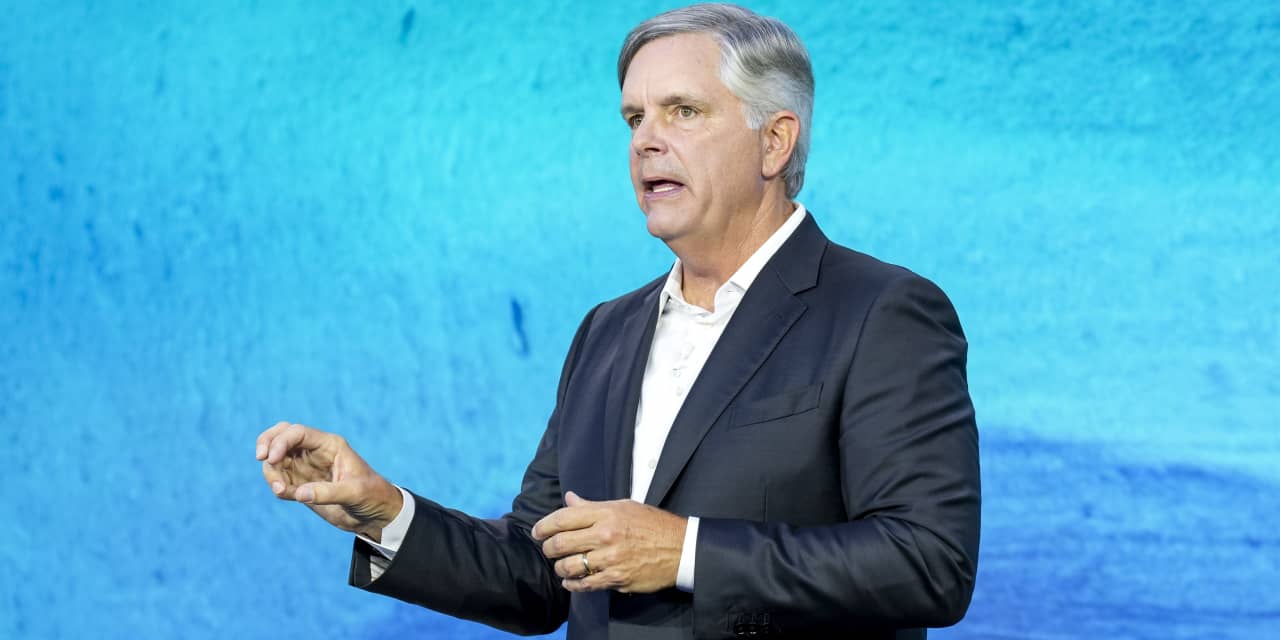It isn’t easy to get
General Electric
CEO Larry Culp to reflect on the past. “I can’t change the past, best I can tell,” Culp tells Barron’s.
Culp seems almost hard-wired to be forward-looking. Even his reflections are geared toward “learning” to figure out what he could have “done better” and apply to the future.
Still, with the monumental breakup of GE, spearheaded by Culp, just about done, he was feeling a little more reflective than usual, making now a good time to see what he thinks about his past few years at GE—and, yes, what’s ahead for the company.
On Friday, GE published its final annual report ever as just GE. In a few more weeks, it will break apart into GE Aerospace, led by Culp, and GE Vernova, led by Scott Strazik. Aerospace is GE’s aviation business, which builds commercial and military engines. Vernova contains GE’s power-generation businesses, including gas and wind turbines and grid technologies.
GE Healthcare Technologies
was spun out at the start of 2023.
When complete, there won’t be a company that simply goes by the moniker “General Electric” since the firm was first incorporated in 1892.
Culp isn’t sad about what’s coming. “All three of us take the monogram,” he says, referring to the GE logo with its script font inside a circle. “I’m pretty sure [founder Thomas] Edison, and the rest of them, are looking down, and saying this is the right thing.”
Culp’s history with the company goes back to 2018; he joined the board that April before being named CEO that October—amid significant business turmoil. GE had too much debt and several underperforming businesses.
“The absolute leverage loomed large,” says Culp, adding that the “denominator” was deteriorating. Businesses, to judge their financial health, typically divide debt,—the numerator—by earnings or cash flow—the denominator.
By that measure, the patient was in critical condition. GE’s industrial businesses generated free cash flow of $5.6 billion in 2017, $4.5 billion in 2018, and $3.9 billion in 2019.
Things have improved. GE generated $5.2 billion in free cash flow in 2023 and should generate more than $6 billion in 2024.
Talking about GE circa 2018 requires the “industrial businesses” modifier because GE Capital had its own earnings, debt, and problems that required separate analysis. GE Capital reported an adjusted loss of $530 million in 2019 after an adjusted loss of $316 million in 2018.
Things weren’t great, so Culp went on one of the greatest debt-reduction streaks in recent memory. Through a combination of asset sales and generated cash flow GE has paid down more than $100 billion in debt since the end of 2018.
GE Capital is now gone, and GE Healthcare Technologies started life with an investment-grade balance sheet. That’s the plan for both GE Aerospace and GE Vernova, too. Those businesses host early March investor events that will provide more detail about expected earnings, cash flow, and debt levels.
GE Aerospace doesn’t have much to do to convince investors it’s a great business. It has a leading market share in commercial jet engines. Vernova has a tougher job.
Vernova’s wind business has lost money in recent years, just like other industry players. What’s more, Vernova’s overall Ebitda profit margins are in the mid-single digit range. (Ebitda is short for earnings before interest, taxes, depreciation, and amortization.) The average Ebitda margin for an
S&P 500
company is roughly 20%.
Investors will have questions about Vernova’s path to higher, and consistent, profits. Culp is confident, though: “Vernova is going to surprise a lot of people.”
If it does, Culp will deserve some of the credit. His devotion to lean management—a set of tools with roots in statistical process control—has led to tangible improvements. GE Vernova eked out an operating profit in 2023 after posting a billion-dollar loss in 2022.
He was careful to point out there were multiple authors of the annual letter that bears his signature. The letter “did trigger more reflection than is typical, given what we’ve accomplished, but I think the tone is of the beginning,” said Culp. “Rest assured, for [GE], it’s all about tomorrow.”
He’s forward-looking to the end.
GE stock gained 0.8% in Friday trading. The S&P 500 and
Nasdaq Composite
rose and 1.7%, respectively. The indexes were powered, in part, by
Meta Platforms
shares’ 20% gain, which added some $200 billion in market capitalization.
Write to Al Root at [email protected]
Read the full article here




